We are back with part two of our look at runway shows and how designs shown at fashion week are altered before being worn by the Duchess. This was originally slated to be posted on Monday, but with all of the fun photos from Sophie Carter’s wedding, it seemed better to wait a bit.
However, we’re starting the post with outstanding news: Kate is returning to formal engagements as she ends her maternity leave. This morning Kensington Palace announced an engagement for the Duchess next Tuesday, October 2nd.  The engagement is at the Sayers Croft Trust Forest School and Wildlife Garden in Paddington. The Sayers Croft Trust is outdoor education charity that works to involve “local community, especially young people, in the enjoyment and care of the environment.” Kate “will see first-hand the positive impact that the Forest School has on children’s emotional and physical wellbeing as she is shown the wildlife garden and meets children involved in exploratory and investigative outdoor activities.”
The engagement is at the Sayers Croft Trust Forest School and Wildlife Garden in Paddington. The Sayers Croft Trust is outdoor education charity that works to involve “local community, especially young people, in the enjoyment and care of the environment.” Kate “will see first-hand the positive impact that the Forest School has on children’s emotional and physical wellbeing as she is shown the wildlife garden and meets children involved in exploratory and investigative outdoor activities.”
++++++++++++++++++++++++++++++++++++++
Now for our look at the changes made to some designer styles before they are worn by Kate, beginning with designs that received little or no modification. Excluded from the post: the standard tailoring of pieces for basics like fit and length. Our first design is the Anna Sui dress worn when the Cambridges were on tour in April 2016. It is from the designer’s a/w 2015 collection and called the Printed Crinkled Silk Chiffon and Twill Dress. As best I could see, it doesn’t look like there were changes made to Kate’s dress other than lengthening it a little.
Another instance where I’m not sure there were changes to the garment, the Erdem Alouette worn to the 100 Women in Hedge Funds dinner in October 2015. It’s possible some of the skirt volume was taken out, but it’s difficult to tell from the photos.
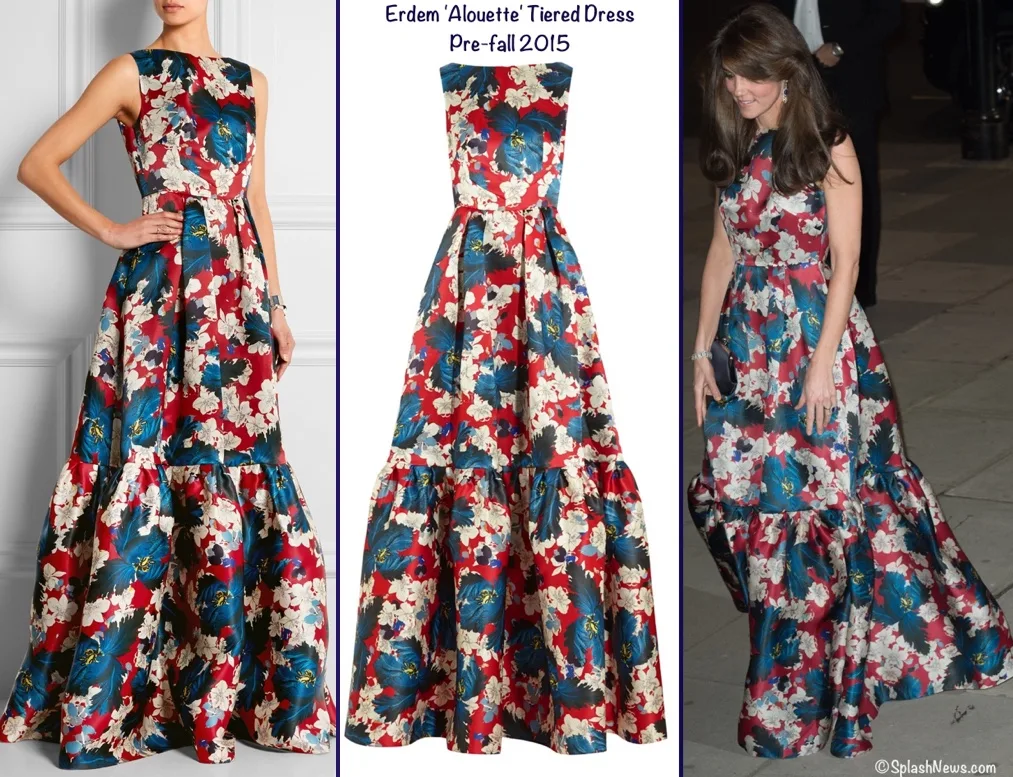
Many of Kate’s Jenny Packham designs are worn much as they were shown on the runway or on a model.
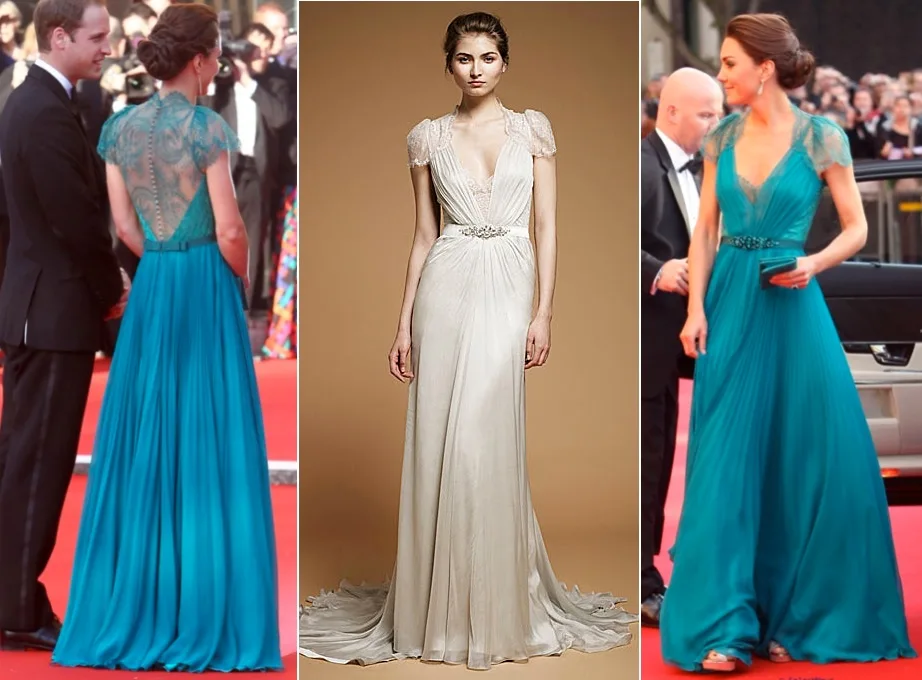
Kate’s BAFTA gown is almost identical to that shown on the runway dress.
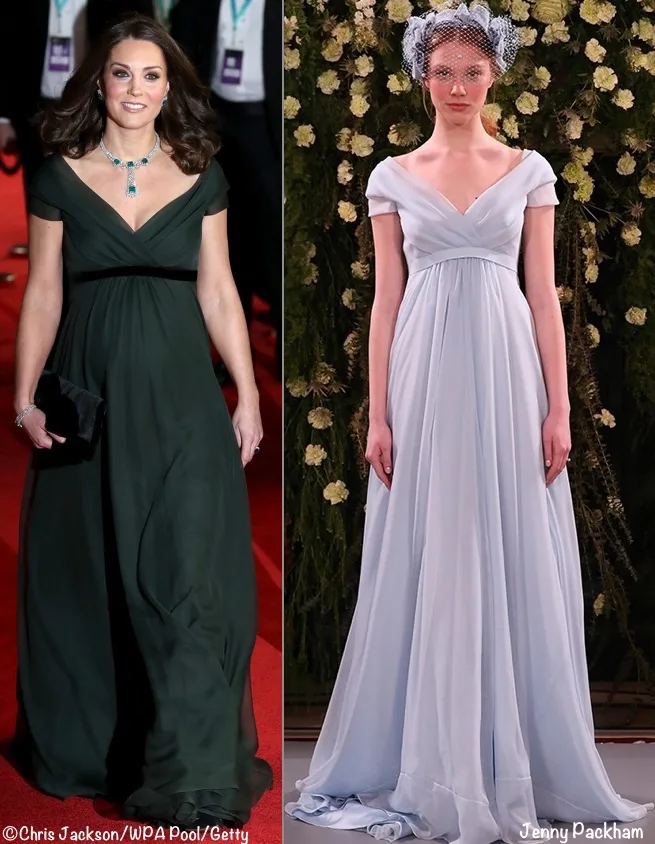
Sometimes changes are subtle, like those made to the Amanda Wakely dress the Duchess wore in October 2011 for her first solo engagement. While Kate’s gown may appear identical to that shown on the runway, the waistline of her dress was altered, significantly raising the embellished waist. An ancillary point of interest with this piece: it is from the designer’s 2006-2007 collection, so when Kate wore it in 2011 she had owned it for quite some time.
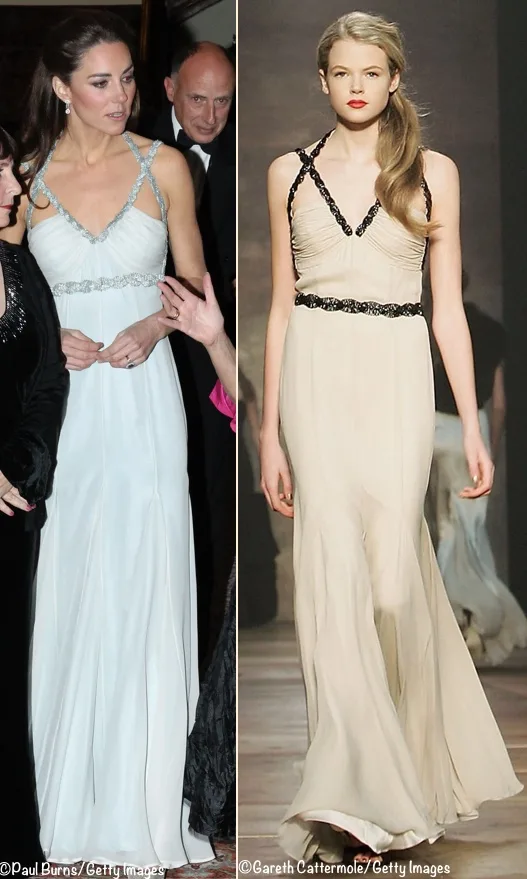
Often the modifications are easy to see, as with this Erdem frock worn to a September 2012 reception at the British High Commissioner’s residence in Singapore. Flyaway sleeves and a lined bodice were added; if I recall properly, there was also an exposed back that was eliminated. 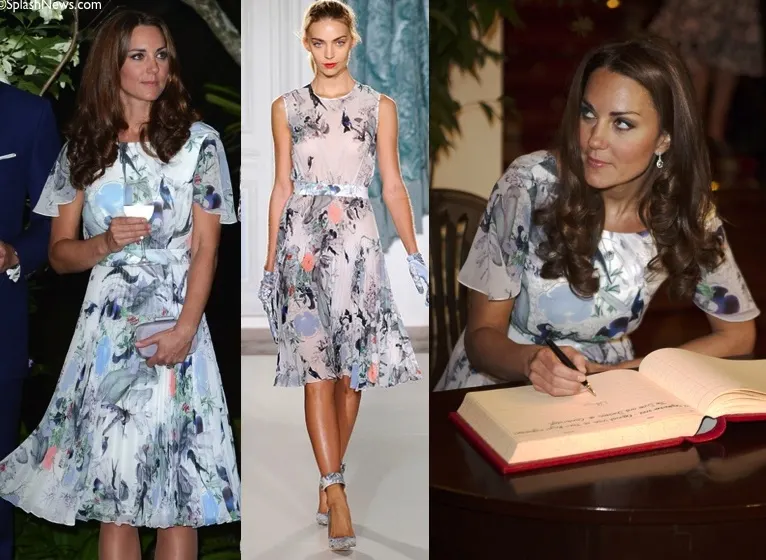
Another example of an obvious change: the Erdem seen at a Buckingham Palace reception this February. The Duchess modified the Suzi Guipure Lace Dress to accommodate her pregnancy and personal taste, resulting in a dress much longer than the OTR (off the rack) version shown below. (I am waffling on whether or not the vee-neckline on Kate’s dress is a little deeper than that shown on the model.) 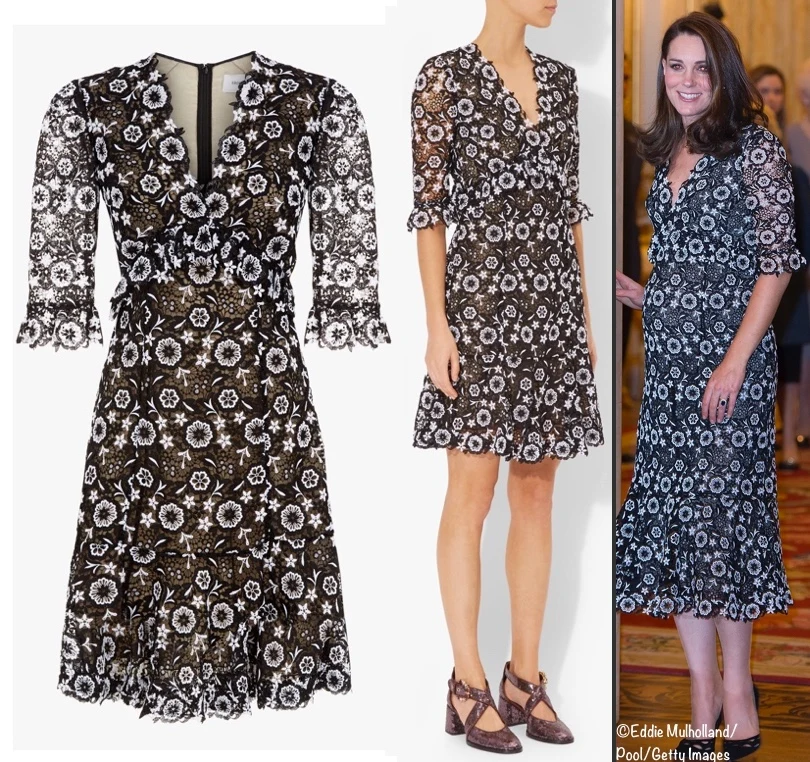
You can also see the changes to a Matthew Williamson dress first worn to a 2012 Tusk Trust event and again at a Place2Be function in 2015. Below, the pre-fall 2012 design and the modified version made for the Duchess; the jeweled trim seen at the cuffs was added to the neckline of her dress, and I believe her frock may have been a bit shorter than what is seen on the model. 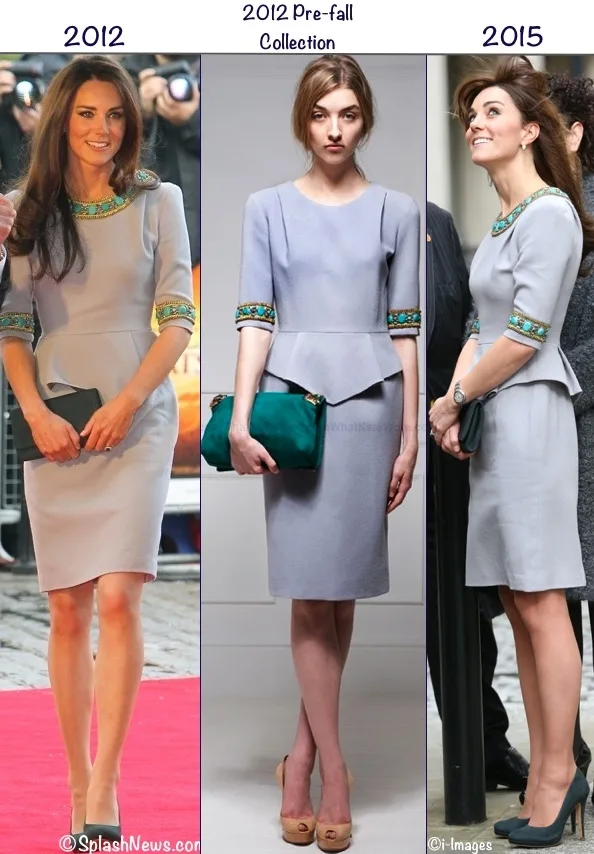
There are times when an existing design is simply made in another color (that may or may not have other changes), as with this Wedgwood blue Temperley London dress worn to an afternoon tea in Kuala Lumpur. It is almost identical to the Aster Flower Dress from the a/w 2012 collection, featuring the same bateau neckline and sheer overlay. The only design difference of note; Kate’s sleeves are three-quarter length as opposed to the full-length sleeves shown on the runway. 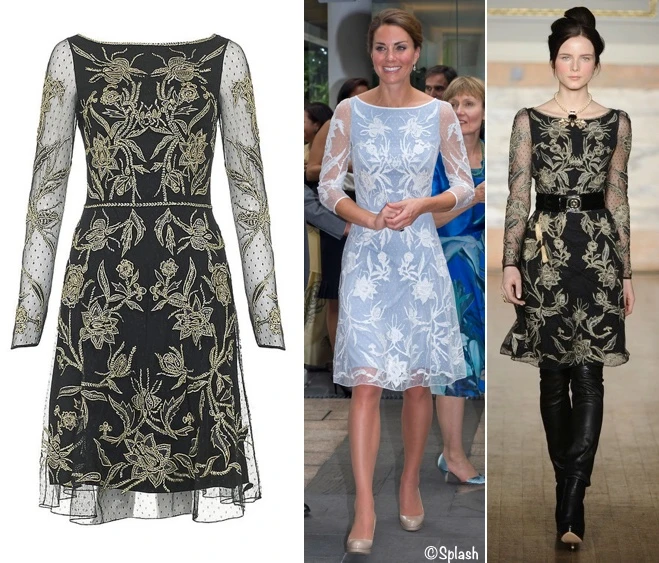
This Temperley design showcases what we affectionately call “Fun With Math,” showing how the lace gown worn for a March 2017 National Portrait Gallery gala was a mix of designs elements from Temperley’s Cleo and Ariel dresses. 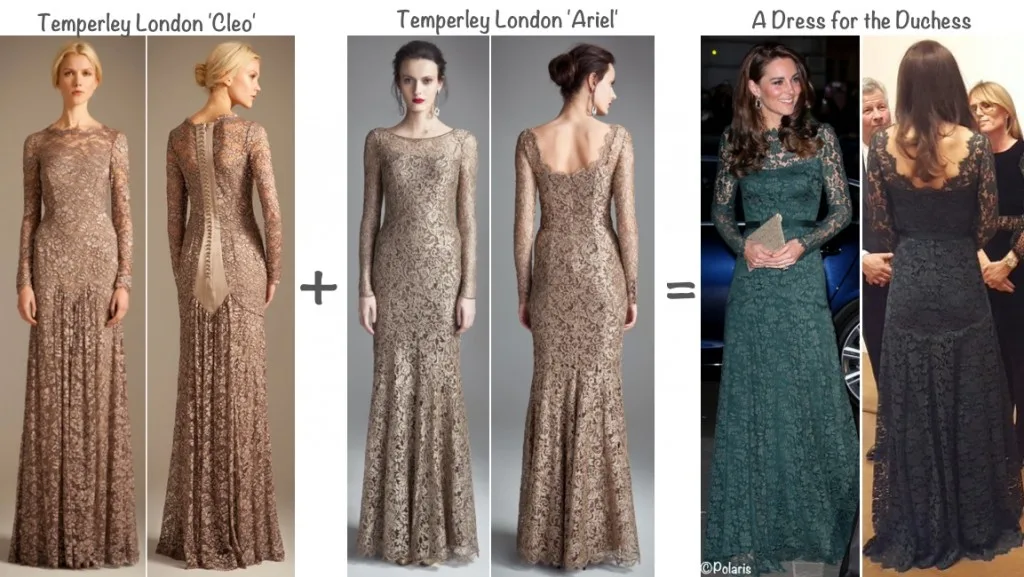
Another instance where multiple designs provided the elements used in a final piece, Kate’s Jenny Packham dress worn to Wimbledon this year.
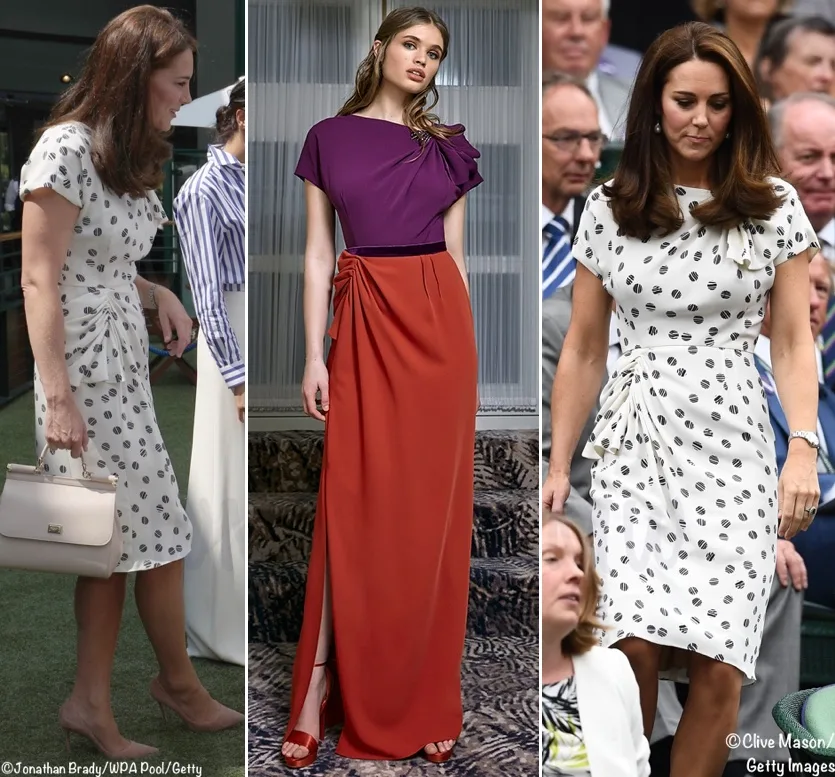
Some of the most dramatic changes we see are those made to Alexander McQueen pieces. Below, Kate at Prince George’s christening, with the RTW dress shown on the left and a portion of a runway piece that Kate’s look is modeled after on the right. 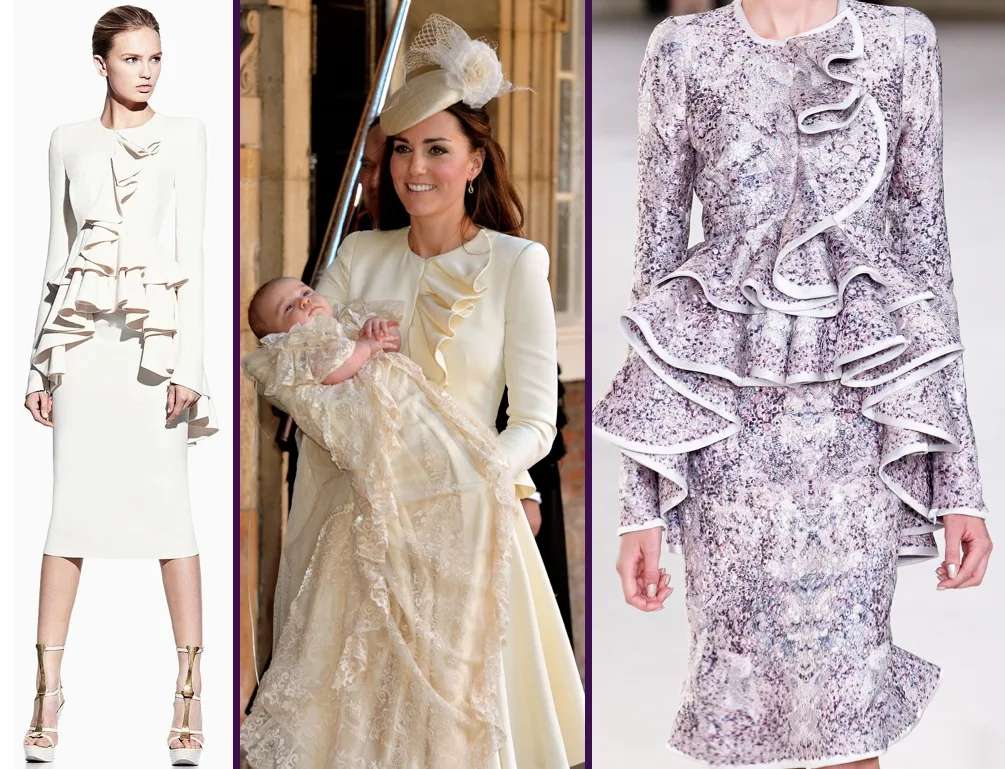
Another view of how the two related styles appeared in the spring/summer 2012 runway collection.
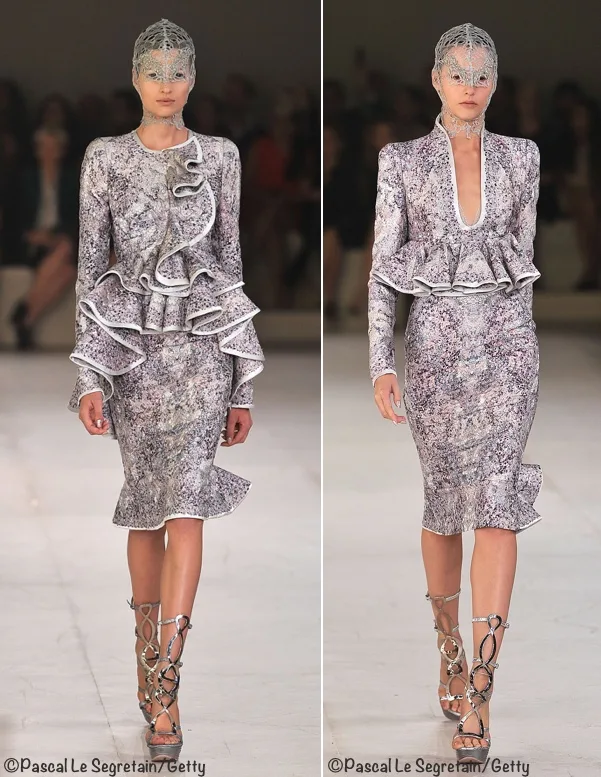
These images better show how the ruffles were minimized for the Duchess in comparison to the pieces seen above. Not only is the majority of the ruffled trim removed, what remains is smaller in width; the fitted skirt from the original designs has been replaced by a full skirt.
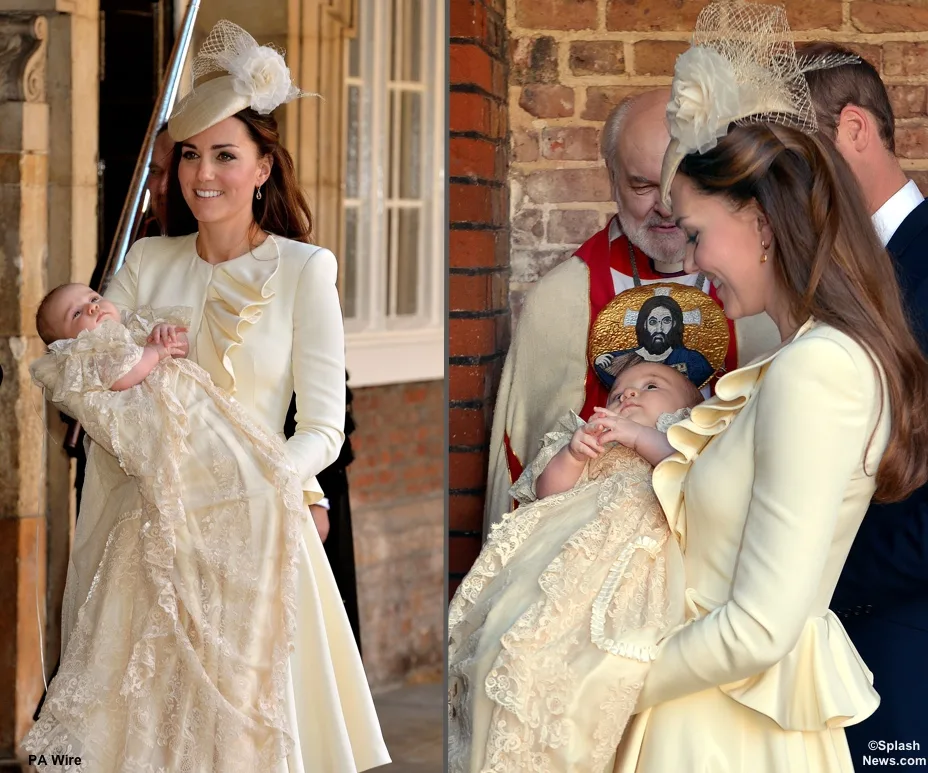
Sometimes only a few elements from an original design are seen in the completed garment Kate wears, as with this dress from the resort 2017 collection. It was first worn in Vancouver during the 2016 Canada tour. The fabric is the same, and the tiered skirt is part of the finished garment, but a good 6″ – 10″ has been added to its length and the sleeve volume is completely gone, replaced by a fitted, full-length style with a solid white cuff. 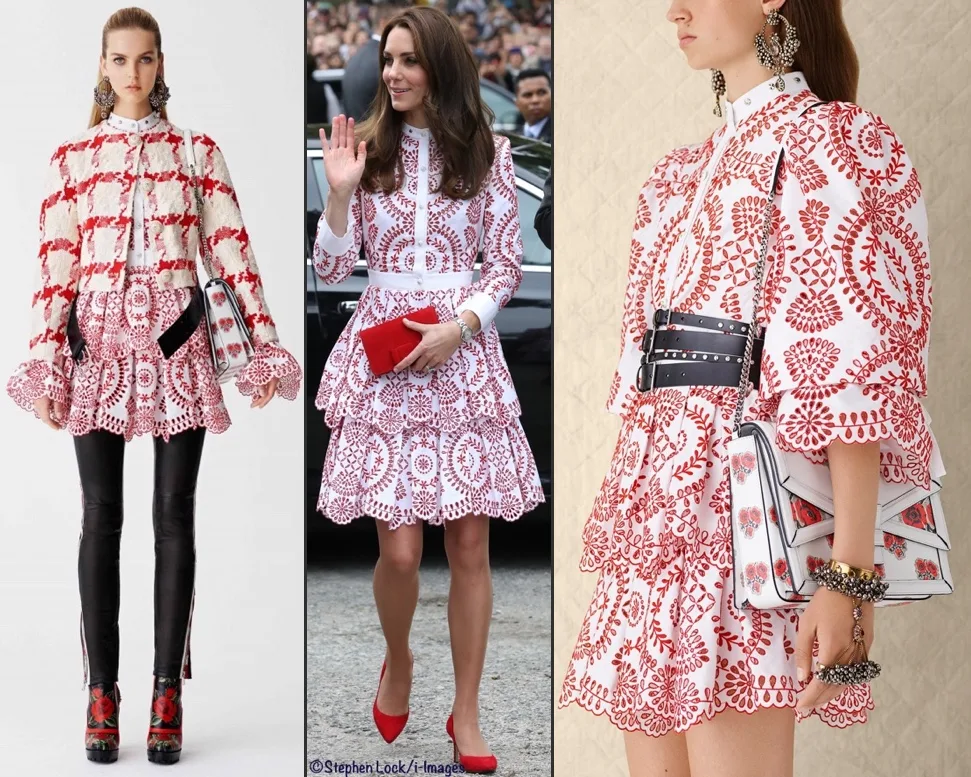
Here is another “Fun With Fashion Math” exercise done for the Duchess’s 2015 Remembrance Sunday coat.
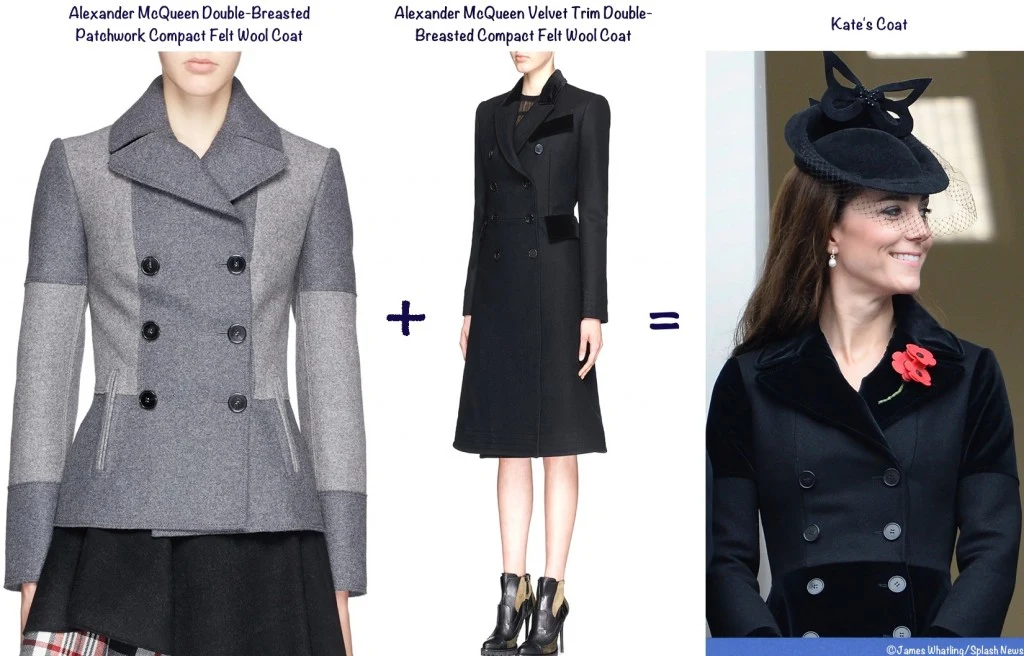
It is with McQueen designs that I hear the most comments about Kate’s garments bearing little resemblance to the design aesthetic associated with Alexander McQueen. There is validity to this perspective; there are garments Kate has worn that have had some/many/all of the most distinctive design elements minimized or removed, resulting in styles that look flat or bland.
Certainly, Kate is not going to wear pieces that showcase the label’s more provocative, controversial design DNA: the subversive, darker, dramatic elements. While she has worn styles incorporating some of the symbols and imagery, you can see with this 2014 Trooping the Colour suit that the incorporation of the skull into the jacquard motif is very subtle, something many would not even notice.
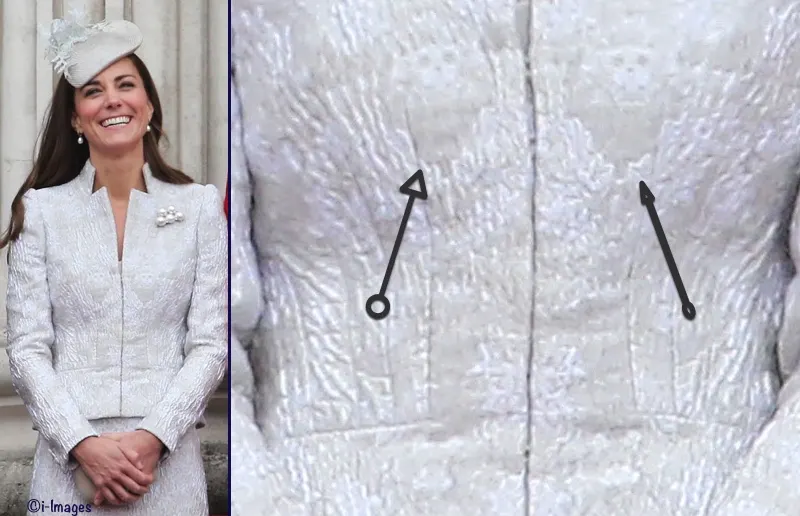
Sarah Burton, who did an amazing job keeping the brand going after Lee McQueen’s death (and continues to do so today), incorporates many of the original design themes into her collections. She has minimized many others, keeping the collections commercially viable while also adding her own signature to the brand. More from PBS:
Sarah Burton, who took over the reins when McQueen died, told The New York Times Style Magazine last year that the company — and the work — had to move on. The McQueen woman that graces the runway these days carefully steps away from the personal demons that fueled Lee’s light-absorbing imagination.
It’s clear that Ms. Burton, as well as her assistants, have a superb understanding of Kate’s needs and an excellent working relationship with the Duchess and her staff; clearly, they deliver clothing and accessories that work for the Duchess. A similar relationship is likely at other labels, particularly Kate’s go-to brands like Jenny Packham, Temperley, Erdem, and Emilia Wickstead.
Another category of modifications to McQueen designs: when Kate carries the brand’s handbags the skull closure has usually (perhaps always) been removed and replaced. Below you see the original hardware in the center photo, and on the right, you can see the closure created to replace the skull. 
In comments, people occasionally ask how a fashion house would handle a request from someone who isn’t just a celebrity, but a member of the royal family. Can they say, “Thank you for your interest, but that just doesn’t feel like something that typifies our brand and we won’t be able to make it for you.” Would a label actually say ‘no’ to a royal inquiry? My guess is probably not. There may be instances of this happening, but I imagine they are few and far between. It is impossible to calculate how great the benefit can be from the recognition and revenue that follow a royal’s stamp of approval for a fashion house, let alone an ongoing relationship that showcases a brand’s designs.
It isn’t just the royals who are having designer styles altered. More from this 2015 Wall Street Journal report.
Celebrities routinely name the designers whose gowns they are wearing to formal events such as the Academy Awards, and designers compete fiercely to dress them. But in reality, such dresses often bear little resemblance to the designers’ work.
Remember when Lupita N’yongo won Best Supporting Actress for 12 Years A Slave at the 2014 Academy Awards? Below, the actress is seen accepting her award in a Prada gown.
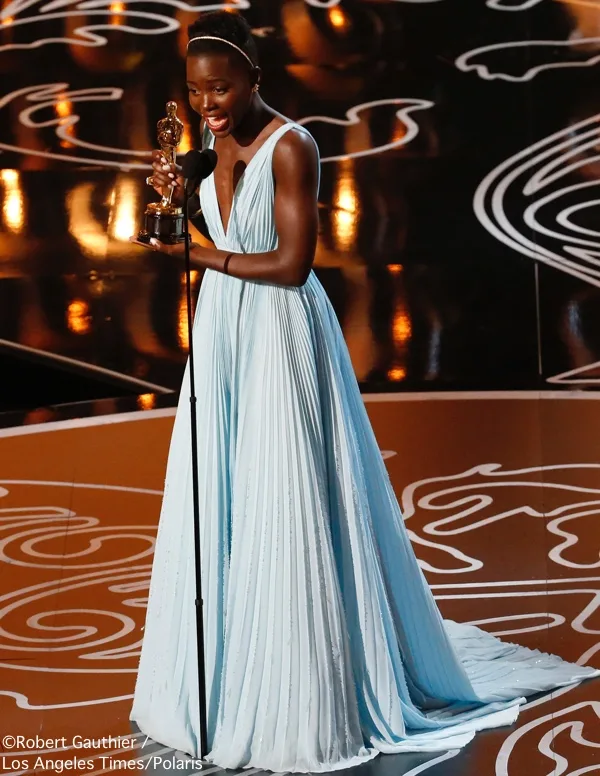
More from Christina Binkley’s WSJ story:
Lupita Nyong’o’s pale blue princess gown at last year’s Oscars was graceful, sexy and utterly feminine. What a surprise, then, that it was from Miuccia Prada, the queen of ugly chic, whose intellectual collections generally eschew the norms of sexy beauty.
A Prada representative declined to comment, saying the label prefers to keep the red-carpet process private. People familiar with the label say Ms. Prada employs a designer to create looks that meet the needs of celebrities on the red carpet.
I did not realize companies may have designs that work primarily/exclusively on celebrity designs. This wraps up our coverage of the subject, but I would love to know if you have other styles that come to mind, pieces substantially altered from their original design. Just leave a comment and I’ll see if I can come up with photos illustrating the changes.
UPDATE: With thanks to Linda G on the Facebook page, here is an example of modifications that were made to an off-the-rack piece. During the India tour the Duchess wore a maxi dress by Glamorous UK. It is a little difficult to see, but Kate had a strip of navy fabric added to the hem of her dress, as well as the waist. 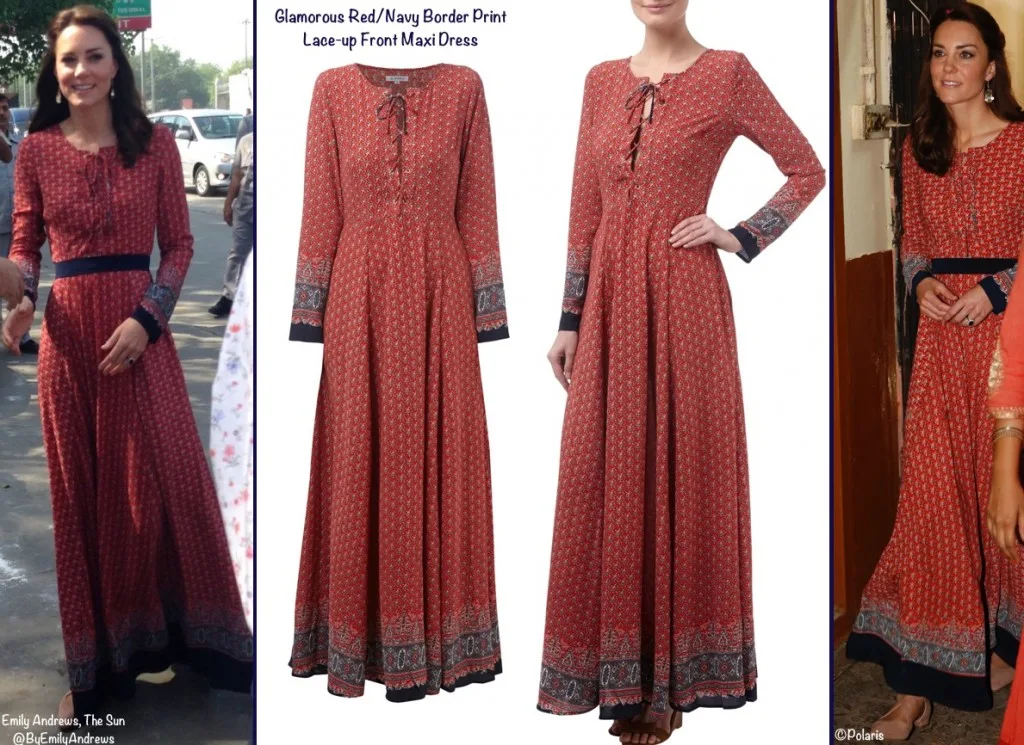
+++++++++++++++++++++++++++++++++++++++++
Our final note today, a reminder more about the ITV documentary Queen of the World.
Part One aired last night on ITV. In the US the program will air on HBO, debuting this Monday (October 1) at 8 pm. It will be available on demand October 2nd. Here are the other times HBO is showing the doc.

We’ll see you Tuesday!
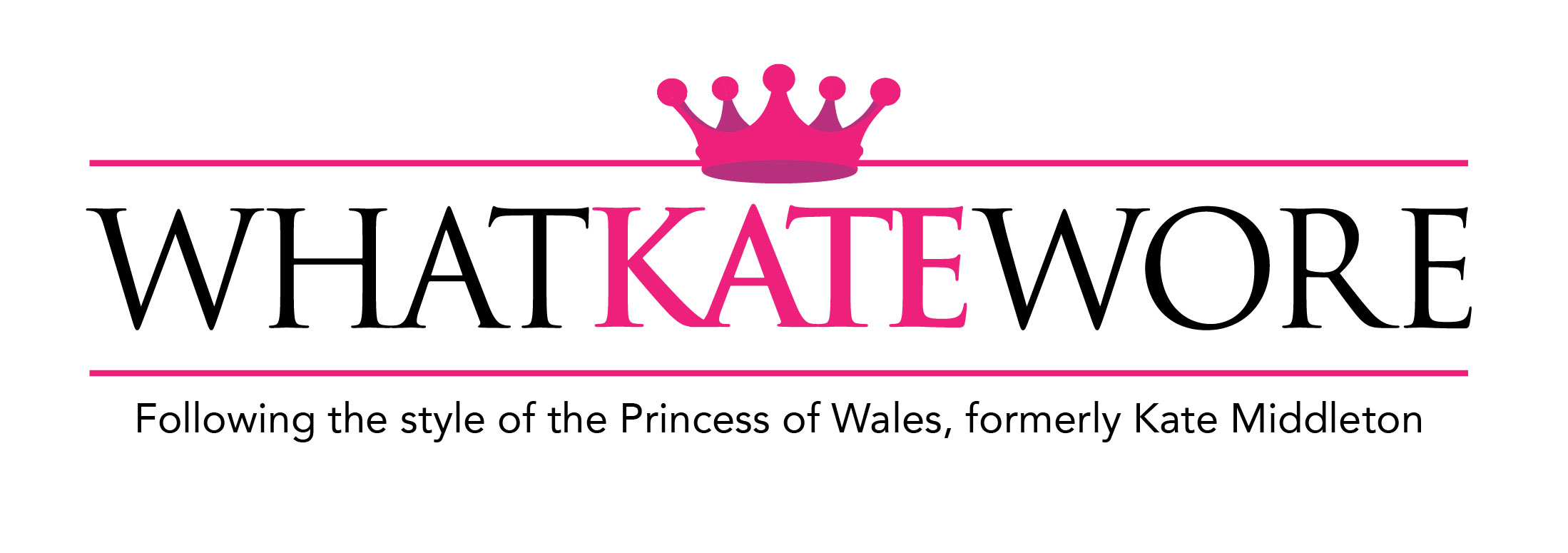

JR
Tuesday 2nd of October 2018
The Anna Sui dress had sleeves significantly shortened from the original piece.
I have no problem with reading of the frustrations in "watering down" design elements designers originally showcased, but the reality is that the wider the reach, the better chance of sales, and the better chance of viability for the fashion house. Fashion-as-art is fascinating, but doesn't fit in at the office, or after-dinner drinks, very well. If you can clothe people other than high-fashion models, actresses on a red carpet, or royalty, you'll simply be around longer. Most of the time the "watered down" is the side that pays the bills, making those outré shows of the fashion art possible.
Lastly, part of the job as a member of the Royal Family is to put people at ease; had Kate showed up in any McQueen pre-modification, she'd be wildly overdressed - overeverything'ed - in relation to those she was meeting. That awkwardness, and the jarring photos that would inevitably accompany the occasion, is something that needs to be avoided, and the Royal Family does this very well.
Jane H.
Tuesday 2nd of October 2018
I thought this was very interesting. Thanks for sharing!
Adrienne
Monday 1st of October 2018
I wonder how far in advance her wardrobe is planned? I am sure it varies, but I am curious about how much time it might take to make some of the these alterations. Great post - I thoroughly enjoy learning about and discussing Kate's fashion.
Erika from Texas
Saturday 29th of September 2018
Thank you for such an interesting post! I know the majority of runway designs are out of my budget, as well as red carpet fashions, but the trends in both those places show up later in more affordable pieces.
I do have one note about the Glamorous UK maxi dress from the India tour. I did buy that dress from the company and mine does have the navy fabric at the bottom, so I don't think the duchess added that to the dress. It is part of the pattern on the fabric, just like the navy part on the end of the sleeves. It would be nicer if it wasn't there, it's a great dress. However, even though I ordered it in petite, it's still long and I wear my Corkswoons with it to give enough height so the hem doesn't drag on the ground.
TravelingBlush
Sunday 30th of September 2018
I believe these modifications (lenght, navy fabric) were made to mimic Kate's dress - the original design was shorter without navy border.
Anne-Christine
Friday 28th of September 2018
So interesting... I had the opposite reaction to Kate's tweak of the Amanda Wakely gown. I absolutely loved what she did to it, and I think the raised waistline emphasizes her height and her willowy figure. I prefer the color, too, to the one on the model. And the change Kate chose for the Matthew Williamson just MADE the look-- the jeweled neckline was a flattering touch, without being overdone. It looked quite plain initially. Looking forward to Kate's October engagement!
Maggie
Saturday 29th of September 2018
I agree that both these changes were an improvement. I am not sure, however, that the changes are always at the suggestion of Kate or her team. It is quite possible that the designers make the changes to give Kate something that cannot be purchased, or just because they understand how and where the garment will be worn and know that the changes will help.